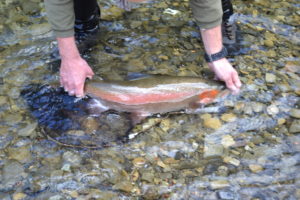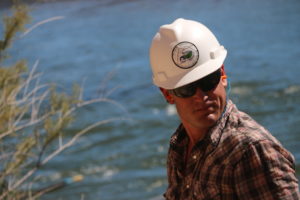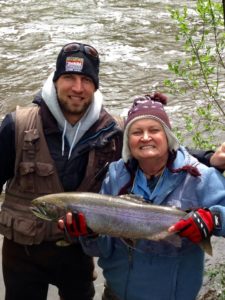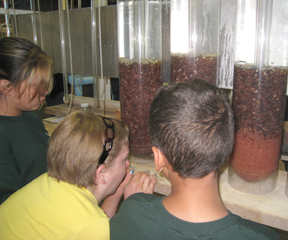Pat Oglesby passed away on December 15, 2016. A lifetime member of Trout Unlimited, Pat was a recipient of the council's highest honor, the Silver Trout award, for his leadership, dedication, and work on protecting Colorado's fisheries. Pat resided in Grand Junction with his wife Carol and was very active with the Grand Valley Anglers chapter of TU. He embodied the true spirit of what Trout Unlimited is all about and will be missed dearly.
The following is a eulogy delivered by Pat's friend Shelley Walchak at the celebration of Pat's life on March 18th, 2017.
By Shelley Walchak
“A limb has fallen from our family tree I keep hearing a voice that says, “Grieve not for me Remember the best times, the laughter, the song. The good life I lived while I was strong. Continue my heritage I’m counting on you, Keep smiling and surely the sun will shine through. My mind is at ease, my soul at rest, Remembering all how I truly was blessed. Continue traditions no matter how small Go on with your life, don’t just stare at the wall. I miss you all dearly, so keep up your chin Until the day comes And we’re together again.” …Author Unknown
The optimistic, upbeat nature of that poem reminds me so much of Pat. It was just about 5 years ago when I met Pat and Carol at the Denver Fly-Fishing Show. I had gone to the show because I had decided I was going to take a year off work and go fly-fishing for a year in the Rocky Mountain States. I needed to find new friends who could help/join me in my quest. I arrived at the show without knowing a soul and approached the IFFF booth to explain myself. I was immediately told that Pat and Carol were the folks I needed to meet. From that day forward a deep and loving friendship developed. A year later I started my journey after much consultation from Pat. I was not long into my journey when I called Pat and Carol to see about a trip to the Taylor River to go fly-fishing. Now, a trip to the Taylor would seem like a perfectly reasonable thing to do except it was January…. And of course the Taylor is near Gunnison, regularly listed as one of the coldest spots in the country. It didn’t matter to me – I was going fishing and I didn’t care what kind of weather I was going to have to endure.
On the last day I saw Pat in October, we talked at length about that trip. He said he had been astonished by my single-mindedness – maybe simple mindedness as well. But, he had agreed to go and I met him and Carol for a couple days in Gunnison.
It had snowed feet just days before we got there but Pat and Carol still showed up. He kept asking me if I still wanted to go and I insisted I did. He was willing to see this through and so we headed up toward Avalanche Hole.
Pat decided he was going to stay up top and spot fish for Carol and me. It was somewhere between 10 – 20 degrees and they both thought I was crazy – but I was in love – in love with fly-fishing and I would do anything to be near a river. And so, Carol and I clamored over 5 foot drifts and made our way down to the river.
After four fishless hours and a propane heater gone dry – we made our way back to Gunnison and ate a hearty meal at a local restaurant. It was no surprise to me that Pat ran into some folks he knew. He seemed to know people wherever he went.
Our excursion ended the next day for them as bad weather rolled in and the temperature dropped even lower. Off they headed to Grand Junction although I was bound and determined to catch at least one fish on the river. Bad weather turned into a blizzard and the fish got the best of me.
It was this passion that we shared deeply – as I’m sure many of you will attest to. Fly-fishing can be a very affirming, very spiritual experience. Pat understood that. Fly-fishing is about ritual and mystery. It’s about acknowledging a power greater than our own. Recognizing that we play a small part in the scheme of things.
It’s also about faith. Faith that the next cast will be the one, that the fish on the line will make it onto shore, and that if this day didn’t go well the next would be better. It’s about our connection to each other, taking comfort in each other’s company and joy in each other’s success.
I found that connection with Pat and he will always have a special place in my heart. Saying these words makes me think of a poem by Delmar Pepper that goes like this.
I've finished life's chores assigned to me, So put me on a boat headed out to sea. Please send along my fishing pole For I've been invited to the fishin' hole.
Where every day is a day to fish, To fill your heart with every wish. Don't worry, or feel sad for me, I'm fishin' with the Master of the sea.
We will miss each other for awhile, But you will come and bring your smile. That won't be long you will see, Till we're together you and me.
To all of those that think of me, Be happy as I go out to sea. If others wonder why I'm missin' Just tell 'em I've gone fishin'
Pat did his good deeds by stealth. He never advertised the fact that he helped so many people in so many different ways. He never talked about his numerous acts of kindness. Yet I believe that almost everyone here today has been at the receiving end of that kindness.
I will miss him as a fountain of general knowledge. If I ever needed to know anything there was always a good chance that Pat would know the answer. If he didn't he'd make sure he found the answer for me.
I will miss him most of all as a friend because good friends like Pat don't happen often in a lifetime. Throughout the years, I’d call to speak with Carol, as a friend and editor of my book, and if Pat picked up, it was an hour before I got to Carol. And sometimes, Carol would have to wait for another day.
To honor Pat, I’m going down to the bank of a river. I’m gonna cast my line out over the swells, and hope for lots of fish, and regardless of whether I get a bite or not…I will be glad and thankful to simply be convening with the spirit of Pat, casting out his own line…not just to pass the time, but to make the passing of time a gift, and a lesson on how life ought to be lived…patient, thoughtfully, and with eager anticipation of the nibble or strike at the hook.
I imagine this is what Pat would say if he could be here…
Don’t grieve for me now, I’m free I’m following the path laid out for me. I turned my back and left it all. I could not stay another day To laugh, to love, to work or play. Tasks left undone must stay that way I’ve found my peace at the close of day.
If my parting has left a void Then fill it with remembered joy. A friendship shared, a laugh, a kiss Ah yes, these things I too will miss.
Be not burdened with times of sorrow. I wish you the sunshine of tomorrow. My life’s been full, I’ve savored much. Good friends, good times, a loved one’s touch. Perhaps my time seemed all too brief
Don’t lengthen it now with undue grief. Lift up your heart and share with me. I am set free.
I give you this one thought to keep I am with you still. I do not sleep. I am a thousand winds that blow, I am the diamond glints on snow, I am the sunlight on ripened grain, I am the gentle autumn rain. When you awaken in the morning’s hush, I am the swift, uplifting rush of quiet birds in circled flight. I am the soft stars that shine at night. So not think of me as gone I am with you still in each new dawn. …Author unknown.






 Growing up on the dirt roads just east of Parker, Colorado, I was fortunate enough to explore the many streams and lakes that this great state has to offer. In particular, I often found myself hiking up small creeks in the Gunnison Basin in search for the pockets of eagerly-feeding brookies that never once questioned my poor presentation or choice of fly. By the time I was twelve years old, I had my own fly rod and I was hooked.
Growing up on the dirt roads just east of Parker, Colorado, I was fortunate enough to explore the many streams and lakes that this great state has to offer. In particular, I often found myself hiking up small creeks in the Gunnison Basin in search for the pockets of eagerly-feeding brookies that never once questioned my poor presentation or choice of fly. By the time I was twelve years old, I had my own fly rod and I was hooked. After moving back to Gunnison in 2013, I worked with a team of fellow raft guides and conservationists to start a non-profit rafting company. River Restoration Adventures for Tomorrow (RRAFT) is a small outfitter dedicated to protecting critical watersheds through community engagement and hands-on restoration work. Over the past three seasons, our team has worked with over 400 community volunteers and youth to conduct various conservation projects on over 300 miles of riparian corridor throughout Colorado and Utah. Our trips ranged from cottonwood planting projects with Delta and Cedaredge High School youth, to overnight trips with the Adaptive Sports Center and Peace of Adventure, to 10-day surveys of invasive plant species along the Colorado River in Cataract Canyon with the National Park Service and the Southwest Conservation Corps Ancestral Lands crews. Not only were we making a difference for the rivers, we were helping to inspire and engage the next generation of stewards.
After moving back to Gunnison in 2013, I worked with a team of fellow raft guides and conservationists to start a non-profit rafting company. River Restoration Adventures for Tomorrow (RRAFT) is a small outfitter dedicated to protecting critical watersheds through community engagement and hands-on restoration work. Over the past three seasons, our team has worked with over 400 community volunteers and youth to conduct various conservation projects on over 300 miles of riparian corridor throughout Colorado and Utah. Our trips ranged from cottonwood planting projects with Delta and Cedaredge High School youth, to overnight trips with the Adaptive Sports Center and Peace of Adventure, to 10-day surveys of invasive plant species along the Colorado River in Cataract Canyon with the National Park Service and the Southwest Conservation Corps Ancestral Lands crews. Not only were we making a difference for the rivers, we were helping to inspire and engage the next generation of stewards. After moving South in the early 1990s I transferred to the Southern Colorado Greenback Chapter of TU. After several years, I was on the Board again, serving mainly in the capacity of Communications Chairman. I will be retiring this year, but plan on maintaining an active role in the chapter. Hubby Paul and I are Life Members, and proud of that.
After moving South in the early 1990s I transferred to the Southern Colorado Greenback Chapter of TU. After several years, I was on the Board again, serving mainly in the capacity of Communications Chairman. I will be retiring this year, but plan on maintaining an active role in the chapter. Hubby Paul and I are Life Members, and proud of that. Kids’ education. Several years ago, Jenny Kedward from the local Sierra Club, Pat McGraw, then-President of our Chapter, and I collaborated to do a two-day summer camp program for 12-14 year olds in our community that concentrated on water education and fishing. We conducted it for four years in a row. Our chapter’s Frostbite Fish-Off Tourney, held for several years, is a close second.
Kids’ education. Several years ago, Jenny Kedward from the local Sierra Club, Pat McGraw, then-President of our Chapter, and I collaborated to do a two-day summer camp program for 12-14 year olds in our community that concentrated on water education and fishing. We conducted it for four years in a row. Our chapter’s Frostbite Fish-Off Tourney, held for several years, is a close second.

 I know you won’t tell me your top spot, so what is your second favorite fishing spot or favorite fishing story?
I know you won’t tell me your top spot, so what is your second favorite fishing spot or favorite fishing story? 
